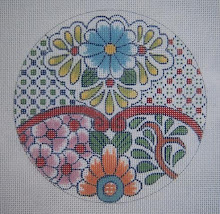 During the 1970's, we worked Bargello usually on 14 mesh canvas with a full three-ply strand of Persian wool, and enjoyed making large items fast - like chair seats and bench covers. It was enjoyable too, in that it was "painting" on bare white canvas, and was very simple to do once the initial pattern was set up.
During the 1970's, we worked Bargello usually on 14 mesh canvas with a full three-ply strand of Persian wool, and enjoyed making large items fast - like chair seats and bench covers. It was enjoyable too, in that it was "painting" on bare white canvas, and was very simple to do once the initial pattern was set up. Now, with 18 mesh canvas availalbe, and lots of pretty novelty threads, it's quite entertaining to make smaller pieces that get no "wear" - like ornaments. I have, for several years, off and on played with these things, mostly interested in combining different surface textures for effect in the threads. I was looking at this egg this morning, and realized I had used nothing more than cotton threads - three different kinds - and a few synthetics.
I chose to use the cotton mainly because I like the effects, such as the ropy twist of the #3 Perle cotton used in upright stitches, with the floss making nice, smooth, flat stitches where I wanted color, but no texture. 

The background for the flower is worked in basketweave with #5 perle cotton. I didn't want to use silk here, as silk, being an animal fiber, would have been slightly ivory, and would have appeared dirty against all that white Ribbon Floss. Cotton is white as it grows, and the animal fibers never bleach to total white. Also, I like, again, the texure of the slight "ropy" twist of the perle cotton on this piece - although I rarely use it for basketweave, preferring the look of floss.. You can see the effects in the close-up, as well as the pretty white Kreinik #032 ribbon.
Using the stranded floss is quite easy, although I have seen people struggle with it a bit, as the little plies want to come loose in the stitching. I solved this one many years ago, in annoyance, by simply making a slip knot up against the eye of the needle - and it doesn't go anywhere. I use a lot of cotton floss, as it lookes almost like silk and is much less expensive.
Anyway, to use floss this way, simply remove  the little tags and open out the entire skein (be sure to remove all cats from the room first). Then put the two ends together, and fold the skein two more times. You will have a "string" about 38" long. Cut the loops at each end. If you are going to do basketweave on 18 mesh canvas, simply remove 2 plies, double this, (to make 4) and put the loop through the eye of your tapestry needle.
the little tags and open out the entire skein (be sure to remove all cats from the room first). Then put the two ends together, and fold the skein two more times. You will have a "string" about 38" long. Cut the loops at each end. If you are going to do basketweave on 18 mesh canvas, simply remove 2 plies, double this, (to make 4) and put the loop through the eye of your tapestry needle.
 the little tags and open out the entire skein (be sure to remove all cats from the room first). Then put the two ends together, and fold the skein two more times. You will have a "string" about 38" long. Cut the loops at each end. If you are going to do basketweave on 18 mesh canvas, simply remove 2 plies, double this, (to make 4) and put the loop through the eye of your tapestry needle.
the little tags and open out the entire skein (be sure to remove all cats from the room first). Then put the two ends together, and fold the skein two more times. You will have a "string" about 38" long. Cut the loops at each end. If you are going to do basketweave on 18 mesh canvas, simply remove 2 plies, double this, (to make 4) and put the loop through the eye of your tapestry needle. 
This might seem a bit long, but the cotton is sturdy, and doesn't fray and wear like wool or silk does. If you are doing basketweave on 13 mesh - or Bargello upright stitches on 18 mesh, you would remove 3 plies, double them, and thread the needle. (then you can put the remaining 3 plies together for the next "needle full") Pull the slip knot tightly up against the eye, and it will give you no difficulty going through the canvas. You will find that every little ply stays absolutely even and flat as you stitch - delightful!!
I'm using more and more cotton floss as I have made a point of trying to use what's in my stash, and have used up much of the silk. For the sake of economy, I am loving reverting to simple DMC or Anchor stranded cotton for these little ornaments. For larger, traditional and elegant pieces - I would, of course, return to using silk for both beauty, and for durability with wear.

1 comment:
That is a good looking egg and I could see it in so many lovely colors :-)
Pierrette =^..^=
Post a Comment